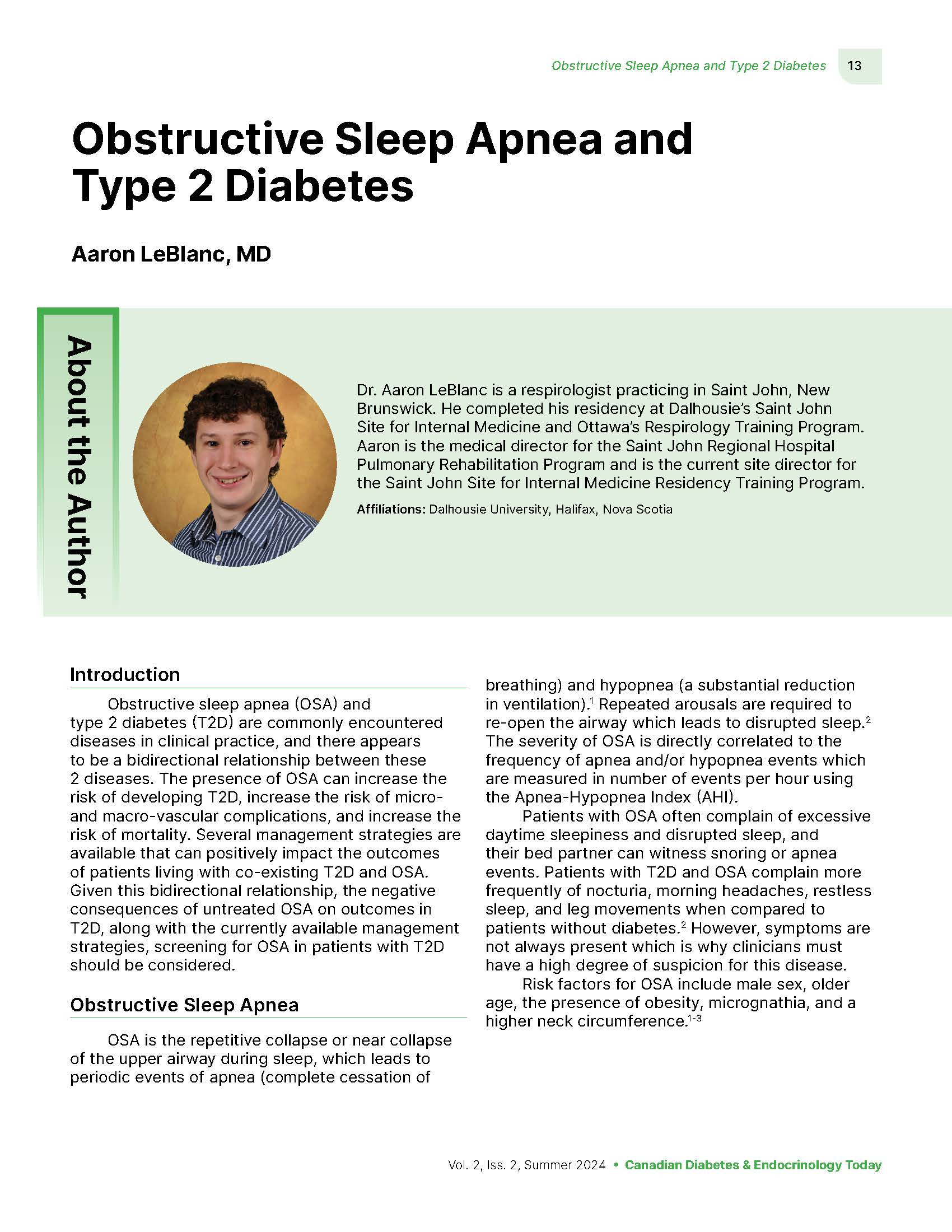Obstructive Sleep Apnea and Type 2 Diabetes
DOI:
https://doi.org/10.58931/cdet.2024.2227Abstract
Obstructive sleep apnea (OSA) and type 2 diabetes (T2D) are commonly encountered diseases in clinical practice, and there appears to be a bidirectional relationship between these 2 diseases. The presence of OSA can increase the risk of developing T2D, increase the risk of micro- and macro-vascular complications, and increase the risk of mortality. Several management strategies are available that can positively impact the outcomes of patients living with co-existing T2D and OSA. Given this bidirectional relationship, the negative consequences of untreated OSA on outcomes in T2D, along with the currently available management strategies, screening for OSA in patients with T2D should be considered.
References
White DP. Sleep-related breathing disorder.2. Pathophysiology of obstructive sleep apnoea. Thorax. 1995 Jul 1;50(7):797-804. doi: 10.1136/thx.50.7.797 DOI: https://doi.org/10.1136/thx.50.7.797
Pataka A, Kalamaras G, Daskalopoulou E, Argyropoulou P. Sleep questionnaires for the screening of obstructive sleep apnea in patients with type 2 diabetes mellitus compared with non-diabetic patients. J Diabetes. 2019;11(3):214-222. doi:10.1111/1753-0407.1283. DOI: https://doi.org/10.1111/1753-0407.12835
Lavrentaki A, Ali A, Cooper BG, Tahrani AA. MECHANISMS OF ENDOCRINOLOGY: mechanisms of disease: the endocrinology of obstructive sleep apnoea. Eur J Endocrinol. 2019;180(3):R91-125. doi: 10.1530/EJE-18-0411 DOI: https://doi.org/10.1530/EJE-18-0411
Heinzer R, Vat S, Marques-Vidal P, Marti-Soler H, Andries D, Tobback N, et al. Prevalence of sleep-disordered breathing in the general population: the HypnoLaus study. Lancet Respir Med. 2015;3(4):310-318. doi: 10.1016/S2213-2600(15)00043-0 DOI: https://doi.org/10.1016/S2213-2600(15)00043-0
Bruyneel M, Kleynen P, Poppe K. Prevalence of undiagnosed glucose intolerance and type 2 diabetes in patients with moderate-to-severe obstructive sleep apnea syndrome. Sleep Breath. 2020;24(4):1389-1395. doi:10.1007/s11325-019-01989-y DOI: https://doi.org/10.1007/s11325-019-01989-y
Kendzerska T, Gershon AS, Hawker G, Tomlinson G, Leung RS. Obstructive sleep apnea and incident diabetes. a historical cohort study. Am J Respir Crit Care Med. 2014;190(2):218-225. doi:10.1164/rccm.201312-2209OC DOI: https://doi.org/10.1164/rccm.201312-2209OC
Adderley NJ, Subramanian A, Toulis K, Gokhale K, Taverner T, Hanif W, et al. Obstructive sleep apnea, a risk factor for cardiovascular and microvascular disease in patients with type 2 diabetes: findings from a population-based cohort study. Diabetes Care. 2020;43(8):1868-1877. doi:10.2337/dc19-2116 . DOI: https://doi.org/10.2337/dc19-2116
Labarca G, Dreyse J, Salas C, Schmidt A, Rivera F, Letelier F, et al. Risk of mortality among patients with moderate to severe obstructive sleep apnea and diabetes mellitus: results from the SantOSA cohort. Sleep Breath. 2021;25(3):1467-1475. doi:10.1007/s11325-020-02283-y DOI: https://doi.org/10.1007/s11325-020-02283-y
Foster GD, Borradaile KE, Sanders MH, Nillman R, Zammit G, Newman AB, et al. A randomized study on the effect of weight loss on obstructive sleep apnea among obese patients with type 2 diabetes. The Sleep AHEAD Study. Arch Intern Med. 2009;169(17):1619-1626. doi:10.1001/archinternmed.2009.266 DOI: https://doi.org/10.1001/archinternmed.2009.266
McEvoy RD, Antic NA, Heeley E, Luo Y, Ou Q, Zhang X, et al. CPAP for prevention of cardiovascular events in obstructive sleep apnea. N Engl J Med. 2016;375(10):919-931. doi:10.1056/NEJMoa1606599 DOI: https://doi.org/10.1056/NEJMoa1606599
Sánchez-de-la-Torre M, Gracia-Lavedan E, Benitez ID, Sánchez-de-la-Torre A, Moncusí-Moix A, Torres G, et al. Adherence to CPAP Treatment and the risk of recurrent cardiovascular events: a meta-analysis. JAMA. 2023;330(13):1255-1265. doi:10.1001/jama.2023.17465 DOI: https://doi.org/10.1001/jama.2023.17465
Herth J, Sievi NA, Schmidt F, Kohler M. Effects of continuous positive airway pressure therapy on glucose metabolism in patients with obstructive sleep apnoea and type 2 diabetes: a systematic review and meta-analysis. Eur Respir Rev. 2023;32(169):230083. doi:10.1183/16000617.0083-2023 DOI: https://doi.org/10.1183/16000617.0083-2023
Sterling KL, Cistulli PA, Linde-Zwirble W, Malik A, Benjafield AV, Malhotra A, et al. Association between positive airway pressure therapy adherence and health care resource utilization in patients with obstructive sleep apnea and type 2 diabetes in the United States. J Clin Sleep Med. 202;19(3):563-571. doi:10.5664/jcsm.10388 DOI: https://doi.org/10.5664/jcsm.10388
Baslas V, Chand P, Jurel SK, Tripathi S, Arya D, Tripathi S, et al. A pilot study to determine the effect of three months of oral appliance therapy using a mandibular advancement device on HbA1c in subjects with type 2 diabetes mellitus and obstructive sleep apnea. J Prosthodont. 2019;28(3):271-275. doi:10.1111/jopr.12973 DOI: https://doi.org/10.1111/jopr.12973
Ibrahim B, Isabel M, Gombar S, Callahan A, Jung K, Capasso R. Association of systemic diseases with surgical treatment for obstructive sleep apnea compared with continuous positive airway pressure. JAMA Otolaryngol Head Neck Surg. 2021;147(4):329-335. doi:10.1001/jamaoto.2020.5179 DOI: https://doi.org/10.1001/jamaoto.2020.5179
Jiang W, Li W, Cheng J, Li W, Cheng F. Efficacy and safety of liraglutide in patients with type 2 diabetes mellitus and severe obstructive sleep apnea. Sleep Breath. 2023;27(5):1687-1694. doi:10.1007/s11325-022-02768-y DOI: https://doi.org/10.1007/s11325-022-02768-y
Patoulias D, Dimosiari A, Michailidis T, Roditis P, Lampropoulos S. Meta-analysis evaluating the effect of sodium-glucose co-transporter-2 inhibitors on the risk for new-onset obstructive sleep apnea in patients with type 2 diabetes mellitus regardless of cardiovascular disease at baseline. Am J Cardiol. 2022;179:116-117. doi:10.1016/j.amjcard.2022.06.022 DOI: https://doi.org/10.1016/j.amjcard.2022.06.022
Zelniker TA, Wiviott SD, Raz I, Im K, Goodrich EL, Bonaca MP, et al. SGLT2 inhibitors for primary and secondary prevention of cardiovascular and renal outcomes in type 2 diabetes: a systematic review and meta-analysis of cardiovascular outcome trials. Lancet. 2019;393(10166):31-39. doi: 10.1016/S0140-6736(18)32590-X DOI: https://doi.org/10.1016/S0140-6736(18)32590-X
Malhotra, Atul, et al. “Tirzepatide for the Treatment of Obstructive Sleep Apnea and Obesity.” New England Journal of Medicine (2024). DOI: https://doi.org/10.1056/NEJMoa2404881
Jiao X, Zou J, Zhang P, Yu H, Di J, Han X, et al. Roux-en-Y Gastric bypass surgery on obstructive sleep apnea-hypopnea syndrome: factors associated with postoperative efficacy. Obes Surg. 2016;26(12):2924-2930. doi: 10.1007/s11695-016-2209-x DOI: https://doi.org/10.1007/s11695-016-2209-x
Peppard PE, Young T, Palta M, Dempsey J, Skatrud J. Longitudinal Study of Moderate Weight Change and Sleep-Disordered Breathing. JAMA. 2000;284(23):3015-3021. doi:10.1001/jama.284.23.3015 DOI: https://doi.org/10.1001/jama.284.23.3015

Downloads
Published
How to Cite
Issue
Section
License
Copyright (c) 2024 Canadian Diabetes & Endocrinology Today

This work is licensed under a Creative Commons Attribution-NonCommercial-NoDerivatives 4.0 International License.
